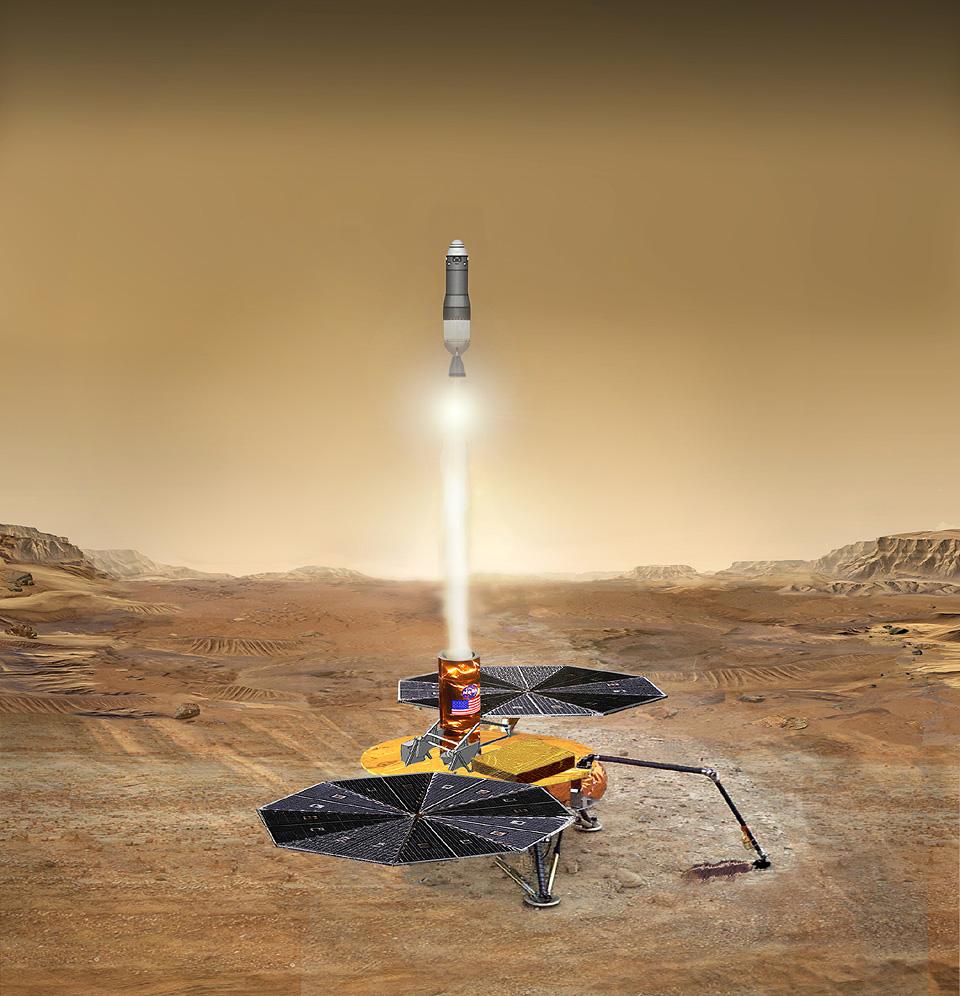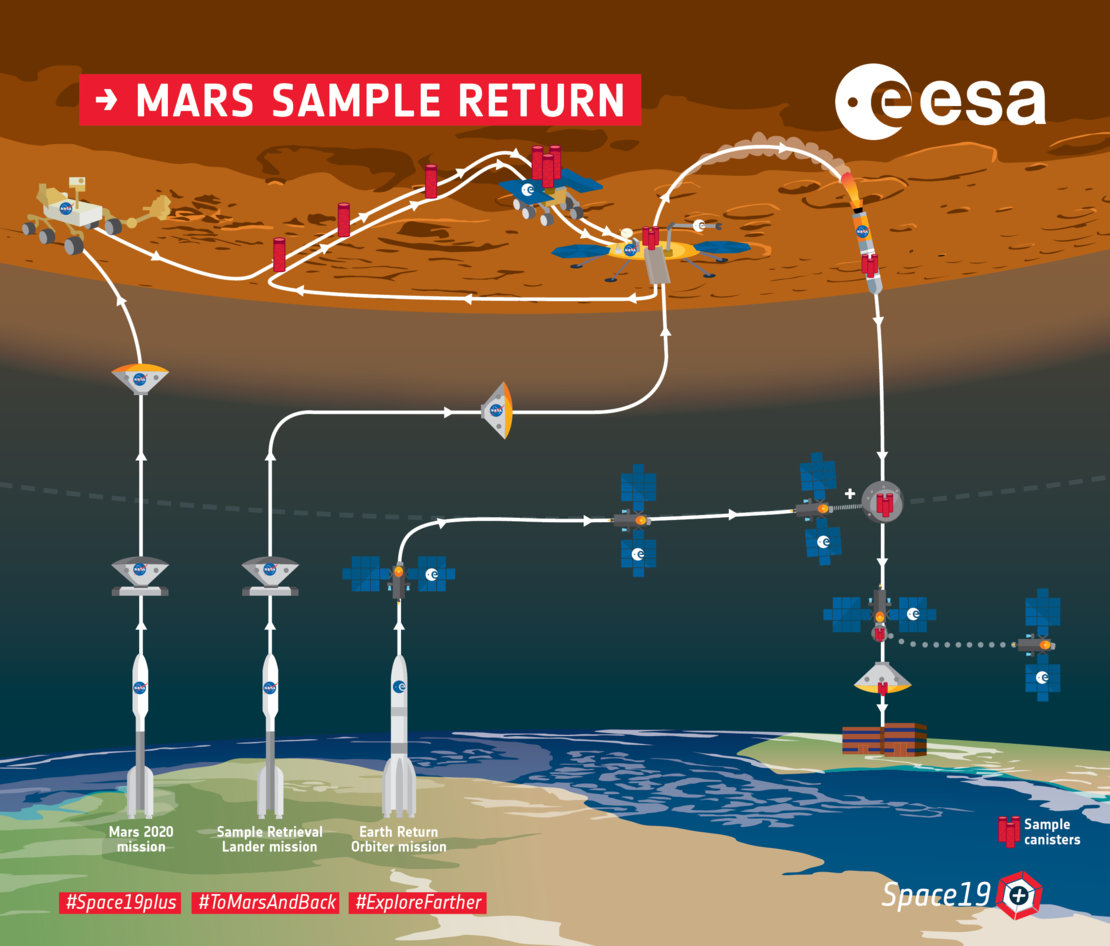Bringing Pieces of Mars to Earth in 2031: How NASA and Europe Plan to Do It

Pristine samples of the Red Planet will come down to Earth a little over a decade from now, if everything goes according to plan.
NASA and the European Space Agency (ESA) are working together on a highly anticipated Mars sample-return mission, which advocates say is the logical next step in our study of the Red Planet and its life-hosting potential.
"We need to bring [Martian] materials back and bring them into our laboratories," Brian Muirhead, of NASA's Jet Propulsion Laboratory in Pasadena, California, said during a presentation with NASA's Future In-Space Operations (FISO) working group last month.
Related: The Search for Life on Mars (A Photo Timeline)
Scientists in labs around the world will be able to analyze such samples much more precisely, and in many more ways, than a rover could do by itself on the Red Planet, helping us "to understand the history of Mars from a biological point of view," added Muirhead, who leads NASA's Mars sample-return campaign.
Researchers could even find signs of life in these Mars rocks, which are scheduled to return to Earth in 2031.
The NASA-ESA plan is not yet official, Muirhead stressed, and details are still being worked out. But here's a rundown of the concept, as it's currently conceived.
Breaking space news, the latest updates on rocket launches, skywatching events and more!
A sample-snagging rover
The campaign begins next July, with the launch of NASA's car-size Mars 2020 rover. The six-wheeled robot is scheduled to touch down in February 2021 inside the 30-mile-wide (50 kilometers) Jezero Crater, which hosted a river delta in the ancient past.
Mars 2020 (which will soon get a catchier moniker, via a student naming competition) will characterize Jezero's geology, hunt for signs of ancient life, demonstrate various technologies that could enable future human exploration of the Red Planet and perform a variety of other work, including the collection and caching of samples.
The rover carries 43 tubes for this purpose, five of which will be "references" that help researchers understand the environment the other tubes have been through, Muirhead said. So Mars 2020 could snag a maximum of 38 samples. Ideally, the rover will drop some of these in an accessible spot and keep others on its body, he added.
The next big step comes in 2026, with the launch of NASA's Sample Retrieval Lander (SRL) mission. SRL will include a stationary lander, the ESA-provided Sample Fetch Rover (SFR) and a rocket called the Mars Ascent Vehicle (MAV), which will be no more than 10 feet (3 meters) tall, Muirhead said.
The mission will touch down near the Mars 2020 landing site, and then SFR will hit the red dirt. This little robot will be smaller than NASA's golf-cart-size Spirit and Opportunity rovers, and it will leverage technology developed for ESA's life-hunting ExoMars rover, which is scheduled to launch toward the Red Planet next summer, just a week after Mars 2020 does.
The SFR will carry no science instruments, Muirhead said. Its lone job, as its name indicates, will be to get the samples dropped by Mars 2020 back to the lander, where they will be placed into the basketball-size Orbiting Sample container, or OS. (The sample-return campaign is complex, so it's even heavier on the acronyms than most space missions are.) If Mars 2020 does indeed hold on to some of its collected samples, this bigger rover could roll over to the lander as well.
"We've had to design the lander to accommodate both of these rovers coming and delivering tubes to us," Muirhead said.
Related: The Boldest Mars Missions in History
Launching off the Martian surface
All of this will take time. The SRL surface mission is expected to last about eight months, with five months devoted to fetching, Muirhead said. Meanwhile, the MAV will be sitting there, waiting for its moment.
"It's got to survive the surface environment — mostly [low] temperature, but dust also," Muirhead said. "And then it's got to launch and deliver into Mars orbit. So, it's a challenging environment for rocket propulsion."
Spacecraft have launched from the surface of Earth's moon before — the Apollo missions did this multiple times — but no vehicle has ever left the much more massive Mars after landing there. So the MAV will make exploration history.
The MAV's specs have yet to be firmed up, Muirhead said. The sample-return team is looking at two options: a two-stage solid-propellant version, and a single-stage rocket that employs hybrid propulsion technology. A decision on the design should come by the end of the year, Muirhead said.
After taking the OS on board, the MAV will launch off the solar-powered lander and deploy the OS container into Mars orbit, at least 190 miles (300 km) above the planet's surface. It will be plucked out of the void by the third big piece of this grand plan: ESA's Earth Return Orbiter (ERO).
Bringing it all back home
Like the SRL mission, ERO is scheduled to launch in 2026. ESA recently invited European companies to submit proposals to build the spacecraft.
"The mission is becoming a reality, and we are proud to give European industry the chance to join the challenge," ESA's Orson Sutherland, study manager for ERO, said in a statement.
The ERO will use electric propulsion and feature multistage detachable modules, leveraging technologies developed for the recently launched BepiColombo mission to Mercury, ESA officials said.
The European orbiter will install the newly captured OS inside a sterile containment system and then sterilize the joints of that system, likely using heat, Muirhead said. Such protocols will ensure that no Mars material leaks out during entry to Earth's atmosphere, potentially contaminating our planet.
The containment system will be placed inside a special entry vehicle, which will deploy from the ERO when the spacecraft nears Earth. The entry vehicle will barrel through our planet's atmosphere and slam into a playa, or dry lake bed, in Utah.
The team has designed the entry vehicle to operate without parachutes, relying instead on completely passive technologies. This strategy takes one big potential failure point out of play, Muirhead said.
The entry vehicle will experience impact forces of about 1,000 Gs if it hits the playa dirt, and perhaps 3,000 Gs if it's unlucky enough to slam into a rock, Muirhead said. (The acceleration at Earth's surface due to our planet's gravity is 1 G.)
"We're designing to both of those [scenarios]," he added.
The targeted landing date is 2031. Mars and Earth align favorably for interplanetary launches just once every 26 months. So, if the SRL and ERO aren't ready in 2026, the next opportunity would come in 2028, with a 2033 sample return to Earth.
"But beyond that, we really lose opportunities to do MSR [Mars sample return]," Muirhead said. "This is really a good opportunity, and we're working very hard to make this opportunity pay off."
Waiting for approval
Again, the campaign outlined above is just a concept at the moment. Though the 2020 federal budget request allocates some money to NASA for MSR development, the project is not officially on NASA's books yet, or those of ESA.
So we don't know how much all of this would cost. Muirhead said the team is treating the campaign as cost-constrained with a hard cap, though it's unclear what that cap will be.
MSR will be tough to pull off, requiring "multiple missions that will be more challenging and more advanced than any robotic missions before," ESA officials said in a different statement.
But the team thinks it's up to the challenge.
"The campaign and the design studies that we've been conducting with ESA are proceeding extremely well," Muirhead said. "We are prepared to proceed with this partnership to implement the objectives, pending approval from our respective funding agencies."
- Mars Sample Return: Scientists Debate How to Bring Red Planet Rocks to Earth
- The 7 Biggest Mysteries of Mars
- Why We Can't Depend on Robots to Find Life on Mars
Mike Wall's book about the search for alien life, "Out There" (Grand Central Publishing, 2018; illustrated by Karl Tate), is out now. Follow him on Twitter @michaeldwall. Follow us on Twitter @Spacedotcom or Facebook.

Michael Wall is a Senior Space Writer with Space.com and joined the team in 2010. He primarily covers exoplanets, spaceflight and military space, but has been known to dabble in the space art beat. His book about the search for alien life, "Out There," was published on Nov. 13, 2018. Before becoming a science writer, Michael worked as a herpetologist and wildlife biologist. He has a Ph.D. in evolutionary biology from the University of Sydney, Australia, a bachelor's degree from the University of Arizona, and a graduate certificate in science writing from the University of California, Santa Cruz. To find out what his latest project is, you can follow Michael on Twitter.

